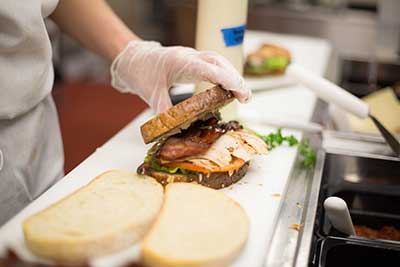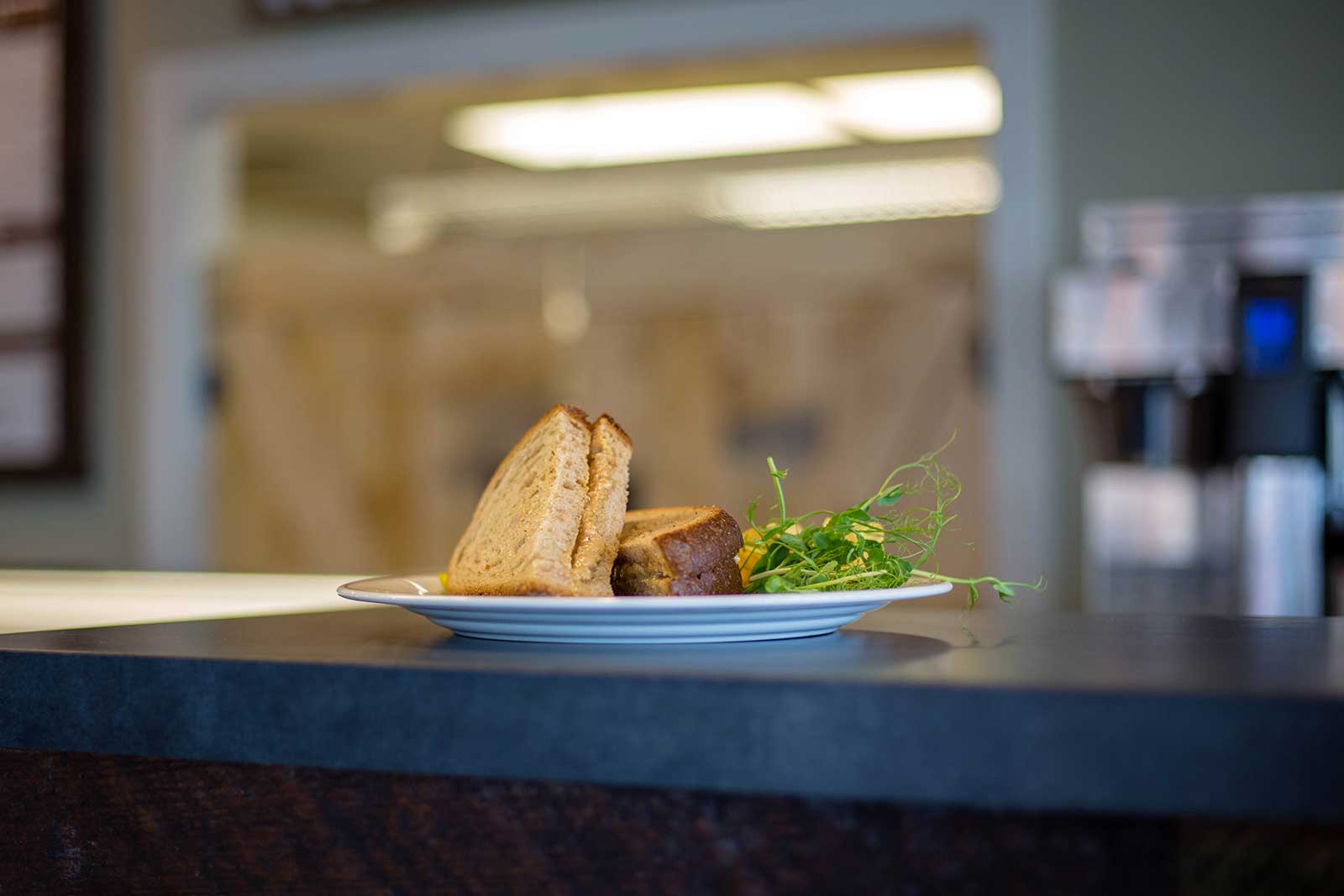There are many points at which one’s understanding of reality could conceivably start to slip while watching a stranger on the internet construct a pie out of Spaghetti-Os. It could be when the cook, a young woman named Janelle Elise Flom, holds up her container of garlic powder to the camera in the exact same way that YouTube makeup artists introduce a lip gloss. It could be when she adds a splash of milk, to make things “juicy.” For me, it is when she uses her forearms to mash butter and granulated garlic into slices of bread that will form the pie’s top crust, and then lets her arms slip unwashed back into the sleeves of her pristine white sweater.
At first, the video—which has been watched more than 43 million times on Facebook and Twitter over a couple of weeks—lulls you into a false sense of security. The scene is overwhelmingly normal. Flom, dressed casually and with beach-waved hair, stands at a stone-topped island in a kitchen straight out of a freshly flipped HGTV house, looking like the kind of mildly famous social-media influencer who attracts an audience by recommending quick family dinners. Then she dumps canned pasta directly into a frozen pie crust.

When you see anything online, it is prudent to ask yourself at least one question before committing to a reaction: Is this a joke? From the Spaghetti-Os pie video alone, it’s hard to know. I reached out to Flom, but she didn’t respond. I watched the video again and again, looking for details that would make it clear whether people on Twitter, who were largely taking it at face value, were getting trolled. Flom plays the scene totally straight, discussing the pie in the buoyant, slightly conspiratorial tone of someone demonstrating a life hack, but she doesn’t cut or taste the pie once it comes out of the oven—is that a tell? I had seen worse food videos. Had I seen worse food videos?
This cycle repeats seemingly every few weeks, when a new food video goes viral for being bizarre or disgusting, either on purpose or accidentally. Many of these videos start out in a familiar way, promising a quick weeknight dinner trick or a money-saving hack to re-create your favorite takeout. Then, they go off the rails. A woman fills a coffee maker with nondairy creamer instead of water and coats her coffee grounds in caramel sauce. What starts out as a recipe for baked barbecue chicken turns into one for a deep-fried, deep-dish barbecue-chicken pizzadilla. Food websites document improbable pizza toppings or extreme sandwiches with high-definition detail. The mysterious French website Chefclub is doing weird things with too much cheese again. Meanwhile, Flom’s Spaghetti-Os pie, which she posted on TikTok and Facebook, is one recipe in a recent wave of bizarre instructional TikToks, sincere or otherwise.
Disgusting food goes viral for the same reason you ask whoever is close by to smell the awful, forgotten thing you just found in the back of the fridge. By the millions, people voluntarily look at things they find revolting, over and over again, before gleefully spreading the experience to others. The cycle continues—more people document themselves trying out the offending recipes, the sense of communal disgust expands—until another video emerges to briefly obliterate our understanding of how other humans eat when the cameras are off. But the mystery here is really about us: Why can’t we look away?
If I had to pick who to blame for the explosion in internet cooking videos—the primordial goo from which viral gross-out cooking crawled—I’d blame BuzzFeed. Under the brand name Tasty, the media company began making short food videos optimized for social media in 2015, using a formula that is now the genre’s aesthetic vernacular: Two disembodied hands preparing food in time-lapse, set to jangly elevator music. No one speaks, and everything goes from mise en place to finished product in a minute, maybe less. Watching people cook (sometimes poorly, or with weird ingredients) was already big business on TV and YouTube, and Tasty proved you didn’t need long shows or detailed instructions to rack up a dedicated following; people simply love watching food come together. Tasty currently has more than 105 million followers on Facebook.
Some of Tasty’s earliest videos foretell the eventual existence of the Spaghetti-Os pie. On OG Tasty, the repository for the site’s older work, the most-viewed recipe, with more than a 100 million views, is for the cheese-stuffed burger dog. It involves fashioning a tube of ground meat around an oblong hunk of cheddar, then grilling everything until molten cheese is squirting out the ends. Many of Tasty’s most successful creations share this Super Bowl–party-from-hell vibe: stuffed tater tots, bacon-wrapped mozzarella sticks, grilled pizza s’mores. The ingredients, like the videos, are quick. You don’t need to make dough in a world with canned biscuits, and you don’t need to thicken a sauce when cream cheese exists. They are food porn in the truest sense: pure pleasure without all the labor, sometimes to the point of grotesquerie.
It’s not an enormous leap from these videos to home cooks who try to build their followings on TikTok or Facebook by showing off their best quick-and-easy recipe hacks. Just as Tasty’s success has been a significant boon to BuzzFeed’s bottom line, viral cooking videos can help their creators amass an audience, sell sponsored content, make endorsement deals, and run ads. For the people who do the best job figuring out what others want to see—by Tasty’s example, it often seems to be quick, comforting, nostalgic foods—and how to get it in front of them, virality can mean realizing the dream of quitting a 9-to-5 job to work for themselves.
To achieve this, recipes that use cheap, widely accessible, shelf-stable ingredients appear to be a good bet. America is not a nation of super-skilled cooks. Most Americans say they don’t consistently enjoy the activity. The country’s food system was industrialized generations ago, which means that most people have little relationship to where their food comes from, and many lack the kitchen skills that might have been a basic necessity for their grandparents. That itself is a marketing opportunity for agricultural conglomerates; separating people from their understanding of what they eat creates a void that can be filled with convenience products and fast food.
For many people, this way of eating isn’t just a cultural reality, but an economic and practical need. Canned goods and processed foods are cheap and plentiful in places where fresh produce often isn’t, and they take some of the prep work out of cleaning and chopping for people who are exhausted or physically unable to do it, or who didn’t get much cooking instruction from their own exhausted parents. The Food Network personality Sandra Lee built an empire out of this style of “semi-homemade” cooking after growing up poor, and is, in some sense, also a foremother of the accidentally viral cooking video—some of her recipes, like her infamous Kwanzaa cake, test the bounds of credulity.
Watching someone in a tastefully appointed luxury kitchen cook with the kinds of foods that affluent Americans frequently eschew can be disorienting; it’s often unclear how much mockery, if any, lurks beneath the surface of any particular video. The ones that take place in normal-person kitchens usually seem more sincere. Either way, it’s easy for things to go awry. Sometimes these amateurs run afoul of how much dairy the wider internet is willing to tolerate, or they put too many soft canned goods in a crock pot set to High. If you know better, the errors are indeed disgusting. If you don’t, maybe Spaghetti-Os are pie filling. Spaghetti pie, after all, is a recipe that sometimes lands in the cookbooks of celebrity chefs.
For viewers who don’t genuinely want help constructing a fast dinner out of shelf-stable ingredients, why keep coming back for more? The internet is brimming with absurdity of all types, so it’s all the more notable that these gross videos seem to be impervious to fluctuating tastes or the whims of an algorithm. If you can’t go viral on your own, all you have to do is find someone absolutely bricking an attempt at pasta Alfredo, slap on a one-liner about the crimes its creator has commited, and virality is yours for the taking.
Alexandra Plakias, a philosophy professor at Hamilton College who studies food, disgust, and moral judgment, watched some of these videos at my request (my apologies to her). She identified a possible explanation for why the recipes bore themselves into our brains: They are minimally counterintuitive ideas. “You take something that’s familiar, but then you put just enough of a twist on it to subvert expectations,” Plakias explained to me. “Minimally counterintuitive concepts are maximally memorable.” This concept was developed by the cognitive anthropologist Pascal Boyer to make sense of which kinds of religious ideas stick—a god with a human visage, for instance. On social media, people mostly already understand the conventions of the quick cooking video—that is, until everything goes left, and the canned pasta goes into the pie crust.
Why we seek out these gross food experiences in the first place is less clear. Disgust, Plakias said, isn’t as well understood as other negative emotions that people pursue voluntarily, like fear, pain, or sadness. Those feelings can confer some physiological benefit—an adrenaline rush, a sense of euphoria, a good cry—when experienced in safe, controlled situations, such as riding a roller coaster, getting a tattoo, or watching a sad movie. Disgust, on the other hand, is mostly an emotion that is useful in real-world situations, where it helps people steer clear of things that might make them sick. There’s little pleasure in feeling like you’re about to barf.
Plakias thinks that the best explanation lies not in our personal reactions to gross recipes, but in our social reactions. For many people, it isn’t enough that they watch, aghast. They also have to smash that RT, because disgust can function as a powerful identity marker—in this case, by helping people to define what they’re not. “We co-opt this kind of disgust response to enforce social norms and moral norms,” Plakias told me. “Our judgments about which foods are disgusting are fairly arbitrary and are mostly culturally determined.” Most Americans, for an example, don’t eat insects, although bugs are a nutritious and sustainable protein source incorporated into food in much of the world. On the other hand, we do largely eat dairy products, which are sort of gross if you think about them for too long.
Whatever the boundaries, these expectations around what is and is not eaten fortify our shared reality. When a recipe goes viral for violating the aesthetic norms of some subset of the internet population—too greasy, too creamy, too mushy, too bland—the response to it often mirrors something Plakias has watched her young son do with his friends: Gleefully declare something to be gross between peals of laughter, buoyed by a small indication that they all understand the world in the same way.
The internet, of course, is just as useful for fracturing shared realities as it is for creating them. I still don’t know whether Flom was joking, and I’m not even sure what it would mean for her to be joking anymore. Her Facebook page, where the video originated, is full of nonculinary pranks identified as such—things like tricking her frequent co-star into grabbing a cactus. But the page’s food section simply advertises videos of “kitchen fun and crazy recipe hacks,” many of which have tens of millions of views. There and on her TikTok account, she has leaned hard into straight-faced gross-out food since the Spaghetti-Os pie went viral, doing things like reconstituting potato chips into mashed potatoes or frying a steak in a thick casing of butter.
When you look at Flom’s videos back-to-back, in the context of all the other things she’s done in apparent bids for social-media virality, she clearly is trolling—the butter arms and all the other weird little details are too conspicuous to be anything but provocative. But that’s still not quite the same thing as joking. Some of the ghastly recipes seem like they work on some level, like her “peach cobbler” made out of Cinnamon Toast Crunch, canned peaches, and cake mix. It looks like a real dessert when it comes out of the oven, and the people who taste it on camera don’t flinch before singing its praises. In the comments, viewers report trying it and loving it, and they recommend tweaks to the recipe for others.
One of Flom’s more outrageous videos, which demonstrates a recipe called Sprite pie, melds two real parts of food history pioneered by the poor: the Depression-era water pie, which mimicked a custard when eggs and milk were scarce, and the use of soda to sweeten desserts and lighten their texture, a long-standing part of Black southern cooking. The recipe had been bandied about among food TikTokers before Flom uploaded her version to Facebook, and one popular DIY chef on YouTube has racked up nearly 1 million views proving that the concoction does indeed work. The filling sets up into a custard, and, apparently, it is sweet and satisfying.
Is Flom joking, or is she serious? Yes. Everything on the internet is a joke until it’s not anymore.









